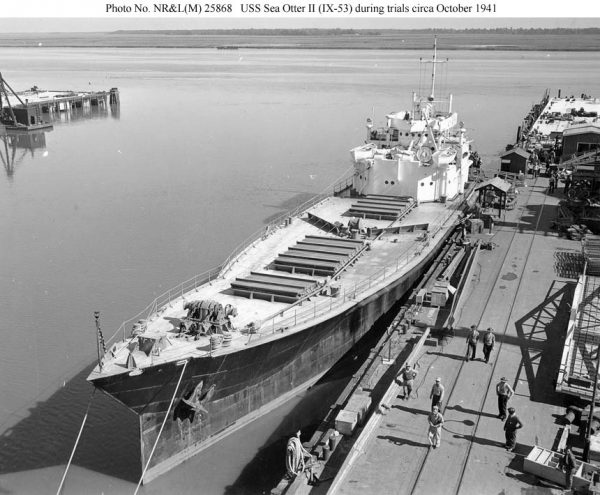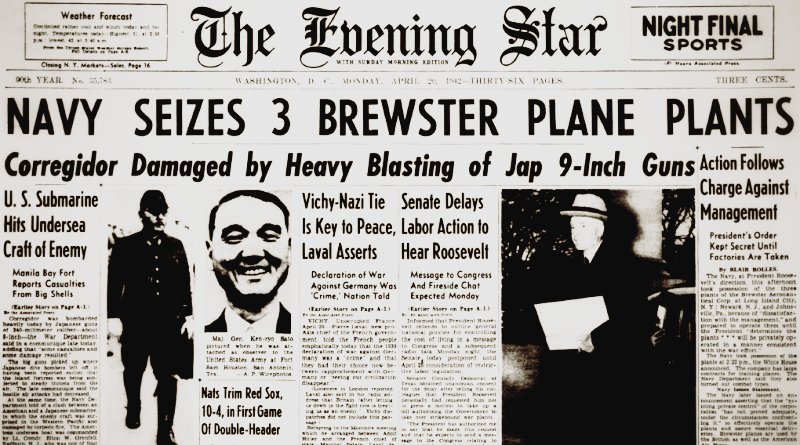World War II Chronicle: April 20, 1942
Click here for TODAY’S NEWSPAPER
Today’s front page reports that Pres. Roosevelt has ordered the Navy to seize Brewster Aeronautical Corp’s factories. The manufacturer of the hopelessly obsolete Brewster F2A Buffalo fell terrifically short of expectations and even the president of the United Auto Workers union asked the government to look into slowdowns at the plants… Boston Braves rookie lefthander Warren Spahn is also on the front page. Spahn made his major league debut yesterday against the New York Giants, retiring both batters he faced. Spahn makes another relief appearance today at Brooklyn, with manager Casey Stengel leaving him in for three full innings. Spahn allows five hits, walks four, and allows four runs. This will be his last appearance until September…
Page two: Japanese radio is reporting that American carrier-launched bombers have hit Tokyo and other cities on mainland Japan, then headed west for China. No word from Washington, as they don’t comment on operations until the units have returned to their bases. Scuttlebutt is that the attack was carried out by North American’s new B-25 Mitchell medium bomber (see page five)…
Lt. Edward H. “Butch” O’Hare, the Naval aviator who shot down six Japanese planes in just five minutes, is pictured on page six. Tomorrow he will become the first pilot of the war decorated with the Medal of Honor. Born in St. Louis, Mo., Butch moved to Chicago with his father when his parents divorced. His dad, a lawyer who worked with Al Capone, was murdered after helping to prosecute the mobster. Butch graduated from Annapolis (Class of ’37) then did two years of sea duty aboard the battleship USS New Mexico before earning his wings of gold. He was assigned to Fighting Squadron 3 (VF-3) embarked aboard USS Lexington when he shot down several Japanese bombers…

The Navy is looking into an experimental cargo ship that will have a draft small enough that torpedoes will pass under it (see page eight). I may be a mere landlubber, but this sounds a little far-fetched. Cargo ships sit low in the water because they are hauling a lot of stuff, and bigger ships aren’t affected by rough seas as much as one that is bobbing along on the tops of the waves. Adm. Samuel Eliot Morison was a bit of an expert on all things Navy, so here’s what he wrote about this project in his History of United States Naval Operations in World War II:
A similarly fantastic proposal for a transatlantic “bridge of ships” was that of the “Sea Otter.” This 270-foot shoal-draft freighter of 1900 tons displacement, designed by an automobile engineer and a retired commander of the United States Navy, was to be propelled by sixteen 110-horsepower gasoline engines arranged radially and coupled hydraulically to four vertical shafts set in cylindrical wells. The ends of the shafts, projecting seven feet below the keep, were equipped with propellers geared at right angles like outboard motors, and could be hoisted up on deck. Torpedoes would pass harmlessly underneath these 10-foot-draft vessels and, so it was claimed, mass production would cost so little that each Sea Otter could be broken up at the end of her first voyage and the engines converted to military use overseas.
16 engines with complicated drivetrains sounds like a lot to go wrong, plus it’s small, and it wouldn’t take long to reconfigure torpedoes to run shallow. But this retired commander knows way more about Navy business than I do, plus they sold the idea to President Roosevelt, who used to be the Assistant Secretary of the Navy. I don’t want to spoil any surprises, but if Sea Otters were a great concept they wouldn’t need any introduction.

Evening star. (Washington, D.C.), 20 April 1942. Chronicling America: Historic American Newspapers. Lib. of Congress.
https://chroniclingamerica.loc.gov/lccn/sn83045462/1942-04-20/ed-1/
